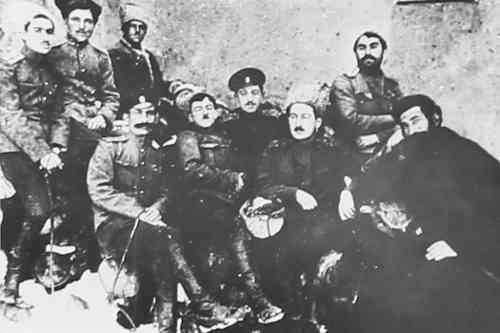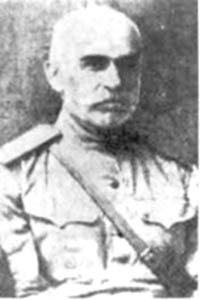Re: Military Notebook: Military Discussions
Armenian National Liberation Movement (1860-1922)
https://en.wikipedia.org/wiki/Armeni...ation_movement
Armenian national liberation movement was the first act to liberate Armenia since 1045 when Armenia was lost and Armenian kingdom of Cilicia in 1375.

Date: circa 17th Century – 1922 (~60 years)
Location: Ottoman Empire (Western Armenia, Cilicia) Russian Empire (mostly the Caucasus)
Result: Partial and temporary Armenian success
-Internalization of the Armenian Question by 1878
-Armenian Genocide in 1915
-Establishment of the Republic of Armenia in 1918
-Turkish Armenia given to Armenia by the Treaty of Sčvres in 1920 Western Armenia given to Turkey in 1921
-Sovietization of Armenia from 1920–22
Influenced by the Age of Enlightenment and the rise of nationalism under the Ottoman Empire, the Armenian national movement developed in the early 1860s. The factors contributing to its emergence made the movement similar to that of the Balkan nations, especially the Greeks.The Armenian élite and various militant groups sought to improve and defend the mostly rural Armenian population of the eastern Ottoman Empire from the Muslims, but the ultimate goal was to push for reforms in the Six Vilayets at first and after this failed, the creation of an Armenian state in the Armenian-populated areas controlled at the time by the Ottoman Empire and the Russian Empire.
Since the late 1880s, the movement turned into an armed conflict (guerrilla warfare) with the Ottoman government and the Kurdish irregulars in the eastern regions of the empire, led by the three Armenian political parties named Hnchak, Armenakan and Dashnak. Armenians generally saw Russia as their natural ally in the fight against Turks, however, Russians as well maintained an oppressive policy in the Caucasus. Only after losing its presence in Europe after the Balkan Wars, the Ottoman government was forced to sign the Armenian reform package in early 1914, pushed by European power and Russia, however, World War I disrupted it.
During World War I, the Armenians living in the Ottoman Empire were systematically exterminated by the government in the Armenian Genocide. According to some estimates, from 1894 to 1923, about 1,500,000—2,000,000 Armenians were killed by the Ottoman Empire. After the decision to exterminate the Armenians was taken by the Ottoman Ministry of Interior and first implemented with the Directive 8682 on February 25, 1915, tens of thousands of Russian Armenians joined the Russian army as Armenian volunteer units with a Russian promise for autonomy. By 1917, Russia controlled many Armenian-populated areas of the Ottoman Empire. After the October Revolution, however, the Russian troops retreated and left the Armenians irregulars one on one with the Turks. The Armenian National Council proclaimed the Republic of Armenia on May 28, 1918, thus establishing an Armenian state in the Armenian-populated parts of the Southern Caucasus.
By 1920, the Bolshevik Government in Russia and Ankara Government had successfully came to power in their respective countries. The Turkish revolutionaries successfully occupied western half of Armenia, while the Red Army invaded and annexed the Republic of Armenia in December 1920. A friendship treaty was signed between Bolshevik Russia and Kemalist Turkey in 1921. The formerly Russian-controlled parts of Armenia were mostly annexed by the Soviet Union, in parts of which the Armenian Soviet Socialist Republic was established. Hundreds of thousands of genocide refugees found themselves in the Middle East, Greece, France and the US giving start to a new era of the Armenian diaspora. Soviet Armenia existed until 1991, when the Soviet Union disintegrated and the current (Third) Republic of Armenia was established.
Up-Coming: Zeitun Rebellion (1895–96)
Armenian National Liberation Movement (1860-1922)
https://en.wikipedia.org/wiki/Armeni...ation_movement
Armenian national liberation movement was the first act to liberate Armenia since 1045 when Armenia was lost and Armenian kingdom of Cilicia in 1375.

Date: circa 17th Century – 1922 (~60 years)
Location: Ottoman Empire (Western Armenia, Cilicia) Russian Empire (mostly the Caucasus)
Result: Partial and temporary Armenian success
-Internalization of the Armenian Question by 1878
-Armenian Genocide in 1915
-Establishment of the Republic of Armenia in 1918
-Turkish Armenia given to Armenia by the Treaty of Sčvres in 1920 Western Armenia given to Turkey in 1921
-Sovietization of Armenia from 1920–22
Influenced by the Age of Enlightenment and the rise of nationalism under the Ottoman Empire, the Armenian national movement developed in the early 1860s. The factors contributing to its emergence made the movement similar to that of the Balkan nations, especially the Greeks.The Armenian élite and various militant groups sought to improve and defend the mostly rural Armenian population of the eastern Ottoman Empire from the Muslims, but the ultimate goal was to push for reforms in the Six Vilayets at first and after this failed, the creation of an Armenian state in the Armenian-populated areas controlled at the time by the Ottoman Empire and the Russian Empire.
Since the late 1880s, the movement turned into an armed conflict (guerrilla warfare) with the Ottoman government and the Kurdish irregulars in the eastern regions of the empire, led by the three Armenian political parties named Hnchak, Armenakan and Dashnak. Armenians generally saw Russia as their natural ally in the fight against Turks, however, Russians as well maintained an oppressive policy in the Caucasus. Only after losing its presence in Europe after the Balkan Wars, the Ottoman government was forced to sign the Armenian reform package in early 1914, pushed by European power and Russia, however, World War I disrupted it.
During World War I, the Armenians living in the Ottoman Empire were systematically exterminated by the government in the Armenian Genocide. According to some estimates, from 1894 to 1923, about 1,500,000—2,000,000 Armenians were killed by the Ottoman Empire. After the decision to exterminate the Armenians was taken by the Ottoman Ministry of Interior and first implemented with the Directive 8682 on February 25, 1915, tens of thousands of Russian Armenians joined the Russian army as Armenian volunteer units with a Russian promise for autonomy. By 1917, Russia controlled many Armenian-populated areas of the Ottoman Empire. After the October Revolution, however, the Russian troops retreated and left the Armenians irregulars one on one with the Turks. The Armenian National Council proclaimed the Republic of Armenia on May 28, 1918, thus establishing an Armenian state in the Armenian-populated parts of the Southern Caucasus.
By 1920, the Bolshevik Government in Russia and Ankara Government had successfully came to power in their respective countries. The Turkish revolutionaries successfully occupied western half of Armenia, while the Red Army invaded and annexed the Republic of Armenia in December 1920. A friendship treaty was signed between Bolshevik Russia and Kemalist Turkey in 1921. The formerly Russian-controlled parts of Armenia were mostly annexed by the Soviet Union, in parts of which the Armenian Soviet Socialist Republic was established. Hundreds of thousands of genocide refugees found themselves in the Middle East, Greece, France and the US giving start to a new era of the Armenian diaspora. Soviet Armenia existed until 1991, when the Soviet Union disintegrated and the current (Third) Republic of Armenia was established.
Up-Coming: Zeitun Rebellion (1895–96)

















Comment